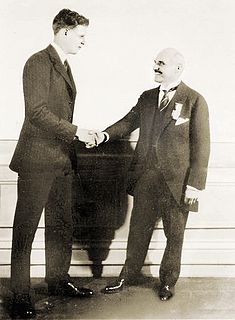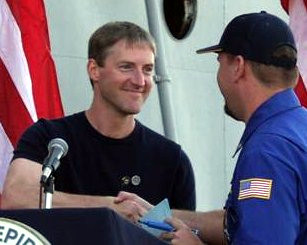
Charles Augustus Lindbergh was an American aviator, military officer, author, inventor, and activist. At the age of 25 in 1927, he went from obscurity as a U.S. Air Mail pilot to instantaneous world fame by winning the Orteig Prize for making a nonstop flight from New York City to Paris. Lindbergh covered the 33 1⁄2-hour, 3,600-statute-mile (5,800 km) flight alone in a purpose-built, single-engine Ryan monoplane, the Spirit of St. Louis. While the first non-stop transatlantic flight had been made 8 years earlier, this was the first solo transatlantic flight, the first transatlantic flight between two major city hubs, and the longest transatlantic flight by almost 2,000 miles. Thus it is widely considered a turning point in world history for the development and advancement of aviation.

Commercial aviation is the part of civil aviation that involves operating aircraft for hire to transport passengers or multiple loads of cargo.

Rear Admiral Richard Evelyn Byrd Jr. was an American naval officer and explorer. He was a recipient of the Medal of Honor, the highest honor for valor given by the United States, and was a pioneering American aviator, polar explorer, and organizer of polar logistics. Aircraft flights in which he served as a navigator and expedition leader crossed the Atlantic Ocean, a segment of the Arctic Ocean, and a segment of the Antarctic Plateau. Byrd claimed that his expeditions had been the first to reach both the North Pole and the South Pole by air. His claim to have reached the North Pole is disputed. He is also known for discovering Mount Sidley, the largest dormant volcano in Antarctica.

Robert Hutchings Goddard was an American engineer, professor, physicist, and inventor who is credited with creating and building the world's first liquid-fueled rocket. Goddard successfully launched his rocket on March 16, 1926, ushering in an era of space flight and innovation. He and his team launched 34 rockets between 1926 and 1941, achieving altitudes as high as 2.6 km (1.6 mi) and speeds as fast as 885 km/h (550 mph).

The Orteig Prize was a reward offered to the first Allied aviator(s) to fly non-stop from New York City to Paris or vice versa. Several famous aviators made unsuccessful attempts at the New York–Paris flight before the relatively unknown American Charles Lindbergh won the prize in 1927 in his aircraft Spirit of St. Louis. However, a number of lives were lost by men who were competing to win the prize. Six men died in three separate crashes, and another three were injured in a fourth crash. The Prize occasioned considerable investment in aviation, sometimes many times the value of the prize itself, and advancing public interest and the level of aviation technology.

The Spirit of St. Louis is the custom-built, single-engine, single-seat, high-wing monoplane that was flown by Charles Lindbergh on May 20–21, 1927, on the first solo nonstop transatlantic flight from Long Island, New York, to Paris, France, for which Lindbergh won the $25,000 Orteig Prize.

George Palmer Putnam was an American publisher, author and explorer. Known for his marriage to Amelia Earhart, he had also achieved fame as one of the most successful promoters in the United States during the 1930s.

The Harmon Trophy is a set of three international trophies, to be awarded annually to the world's outstanding aviator, aviatrix, and aeronaut. A fourth trophy, the "National Trophy," was awarded from 1926 through 1938 to the most outstanding aviator in each of the twenty-one member countries and again from 1946–1948 to honor Americans who contributed to aviation. The award was established in 1926 by Clifford B. Harmon, a wealthy balloonist and aviator.

Erik Robbins Lindbergh is an aviator, adventurer, and an artist. He is the grandson of pioneering aviator Charles Lindbergh the first person to fly non-stop and solo between New York and Paris in 1927. In 2002 Erik Lindbergh honored the 75th anniversary of his grandfather's historic flight by retracing the journey in a single-engine Lancair aircraft. The journey was documented by the History Channel, raised over one million dollars for three charities, garnered half a billion media impressions for the X PRIZE Foundation and helped to jump-start the private Spaceflight industry. The flight prompted a call from United States President George W. Bush for inspiring the country after the tragedy of September 11.

Paul B. MacCready Jr. was an American aeronautical engineer. He was the founder of AeroVironment and the designer of the human-powered aircraft that won the first Kremer prize. He devoted his life to developing more efficient transportation vehicles that could "Do more with less".

Harry Frank Guggenheim was an American businessman, diplomat, publisher, philanthropist, aviator, and horseman.
Paul Kollsman was a German-American inventor. He invented the first sensitive barometer, a key enabler of instrument flight in airplanes.

Daniel Guggenheim was an American mining magnate and philanthropist, and a son of Meyer and Barbara Guggenheim. By 1910 he directed the world's most important group of mining interests. He was forced out in 1922 and retired to philanthropy to promote aviation. His achievements include a system for innovation, as well as leadership in amicable labor relations, and major roles in aviation and rocketry.

Donald Albert Hall was an American pioneering aeronautical engineer and aircraft designer who is most famous for having designed the Spirit of St. Louis.

The Guggenheim Aeronautical Laboratory at the California Institute of Technology (GALCIT), was a research institute created in 1926, at first specializing in aeronautics research. In 1930, Hungarian scientist Theodore von Kármán accepted the directorship of the lab and emigrated to the United States. Under his leadership, work on rockets began there in 1936. GALCIT was the first—and from 1936 to 1940 the only—university-based rocket research center. Based on GALCIT's JATO project at the time, the Jet Propulsion Laboratory was established under a contract with the United States Army in November 1943.

The sole Wright-Bellanca WB-2, named Columbia, Miss Columbia, and later Maple Leaf, was the second in a series of aircraft designed by Giuseppe Mario Bellanca, initially for Wright Aeronautical then later Columbia Aircraft Corp.
The Charles A. Lindbergh Chair in Aerospace History, also known as the Lindbergh Chair, is a one-year senior fellowship hosted by the U.S. National Air and Space Museum (NASM), to assist a scholar in the research and composition of a book about aerospace history. Named for the famous aviator Charles Lindbergh, the position is competitive: one experienced scholar is selected each year from multiple applicants worldwide. Up to $100,000 is granted to the winner.
Montgomery Knight was an aeronautical engineer who specialized in rotary-wing aircraft. He was the first director of the Guggenheim School of Aeronautics at the Georgia Institute of Technology and a founder of and long-time researcher at the Georgia Tech Research Institute.

"WE" is an autobiographical account by Charles A. Lindbergh (1902-1974) about his life and the events leading up to and including his May 1927 New York to Paris solo trans-Atlantic flight in the Spirit of St. Louis, a custom-built, single engine, single-seat Ryan monoplane. It was first published on July 27, 1927 by G.P. Putnam's Sons in New York.
Walter Guido Vincenti was an American engineer who worked in the field of aeronautics, designing planes that could fly at hypersonic speed. He was elected as a member of several scientific societies, including the American Institute of Aeronautics and Astronautics and National Academy of Engineering. He won several prestigious awards, such as the Leonardo da Vinci Medal and the Daniel Guggenheim Medal.

















